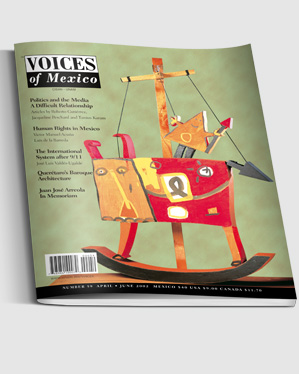Voices of Mexico no. 59
Our Voice
In today’s world, borders are entities in which time and space coexist with an intense simultaneity of flows. As a cultural category and as a political and social reality, they are entities that in and of themselves transcend national sovereignties, ethnic groups, macroeconomic variables, political traditions, etc. Their complex and at the same time fascinating cosmogony make them confront day by day an endless movement whose temporality does not accept a mathematics of their traditional timing. Additionally, they are spaces that change rapidly due to the fact that social, political and economic circulation is both vertical and horizontal; that is to say, they trace an elastic and dynamic regional geometry and produce local phenomena which are unique, to a great extent because they are a-national, a-binational or a-trinational, and even if this becomes cultural “foreignness” in which the universal and the particular dialogue but also confront each other, naturally it also means events that have diverse similarities with the sociopolitical and economic realities that are close to them. Thus, borders dialogue but also confine themselves to themselves and make use of a language that is unique to them and that they inevitably extend to their closest synods, even more when emergencies demand it of them. This is even more common in a transnationalized world like ours in which the construction of bridges toward development and survival are both rational and emotional needs. It is here where the “symbolic reality” of borders paves the way to the “real” and coldly objective reality of nations.
With globalization, the boundaries between the global and the regional blur. The national becomes part of the international; the particular is somehow incorporated into the universal; homogeneity threatens to substitute itself for —and sometimes annihilate— the universal; and sovereignties reoccupy a different conceptual space. This is how borders are submerged in times marked by national discourses and needs and become the integrating —and often disruptive— space for the inevitable interaction between two or more societies and states that design their own strategies and define their own discourses.
Editorial
![]() Our Voice
Our Voice
José Luis Valdés-Ugalde
Politics
![]() Vicente Fox and the Media A Difficult Relationship
Vicente Fox and the Media A Difficult Relationship
Roberto Gutiérrez López
![]() The News Media and Political Competition
The News Media and Political Competition
Jacqueline Peschard
![]() Modern Mexico
Modern Mexico
A Look at Media-Government Relations
Tanius Karam
Society
![]() Panorama of Human Rights in Mexico
Panorama of Human Rights in Mexico
In the Twenty-first Century
Francisco Javier Acuña Llamas
![]() The Thwarted Inevitability
The Thwarted Inevitability
Advances in Human Rights Defense in Mexico City
Luis de la Barreda Solórzano
Economy
![]() Is There an Argentina in Mexico’s Future?
Is There an Argentina in Mexico’s Future?
Berenice P. Ramírez López
United States Affairs
![]() The International System
The International System
Trapped by Its Past, Repeating What It Forgets
José Luis Valdés-Ugalde
![]() Comparing EU and U.S. Foreign Policies after 9/11
Comparing EU and U.S. Foreign Policies after 9/11
María Eugenia Mesta Espinosa
Simone Lucatello
Canadian Issues
![]() Visible Minorities in Canadian Literature
Visible Minorities in Canadian Literature
Mayra Eleonora Inzunza Sánchez
Museums
![]() The Querétaro Regional Museum
The Querétaro Regional Museum
Guadalupe Zárate Miguel
Literature
![]() Of Memory and Forgetfulness
Of Memory and Forgetfulness
Juan José Arreola
![]() The Switchman
The Switchman
Juan José Arreola
![]() The Rhinoceros
The Rhinoceros
Juan José Arreola
In Memoriam
![]() Checkmate to the Switchman
Checkmate to the Switchman
Homero Aridjis
![]() Arreola. The Magician of Midday
Arreola. The Magician of Midday
Christopher Domínguez Michael
Reviews
![]() México y la política comercial externa
México y la política comercial externa
de las grandes potencias
César Guerrero
![]() Europa y la guerra de Estados Unidos
Europa y la guerra de Estados Unidos
contra México
Bibiana Gómez Muñoz
The Splendor of Mexico
![]() The Reflection of a Surrealistic Life
The Reflection of a Surrealistic Life
In Las Pozas de Xilitla
Jaime Abundis Canales
![]() Colonial, Baroque Querétaro
Colonial, Baroque Querétaro
Jaime Ortiz Lajous
Science, Art and Culture
![]() The Painting of Rubén Leyva
The Painting of Rubén Leyva
Eduardo Milán
![]() Quiet Strength
Quiet Strength
Fernando Solana Olivares
![]() The Very Latest in Mexican Cinema
The Very Latest in Mexican Cinema
Leonardo García Tsao
![]() The Lighthouse of the East
The Lighthouse of the East
A Refuge to Illustrate Fantasy
Elsie Montiel

